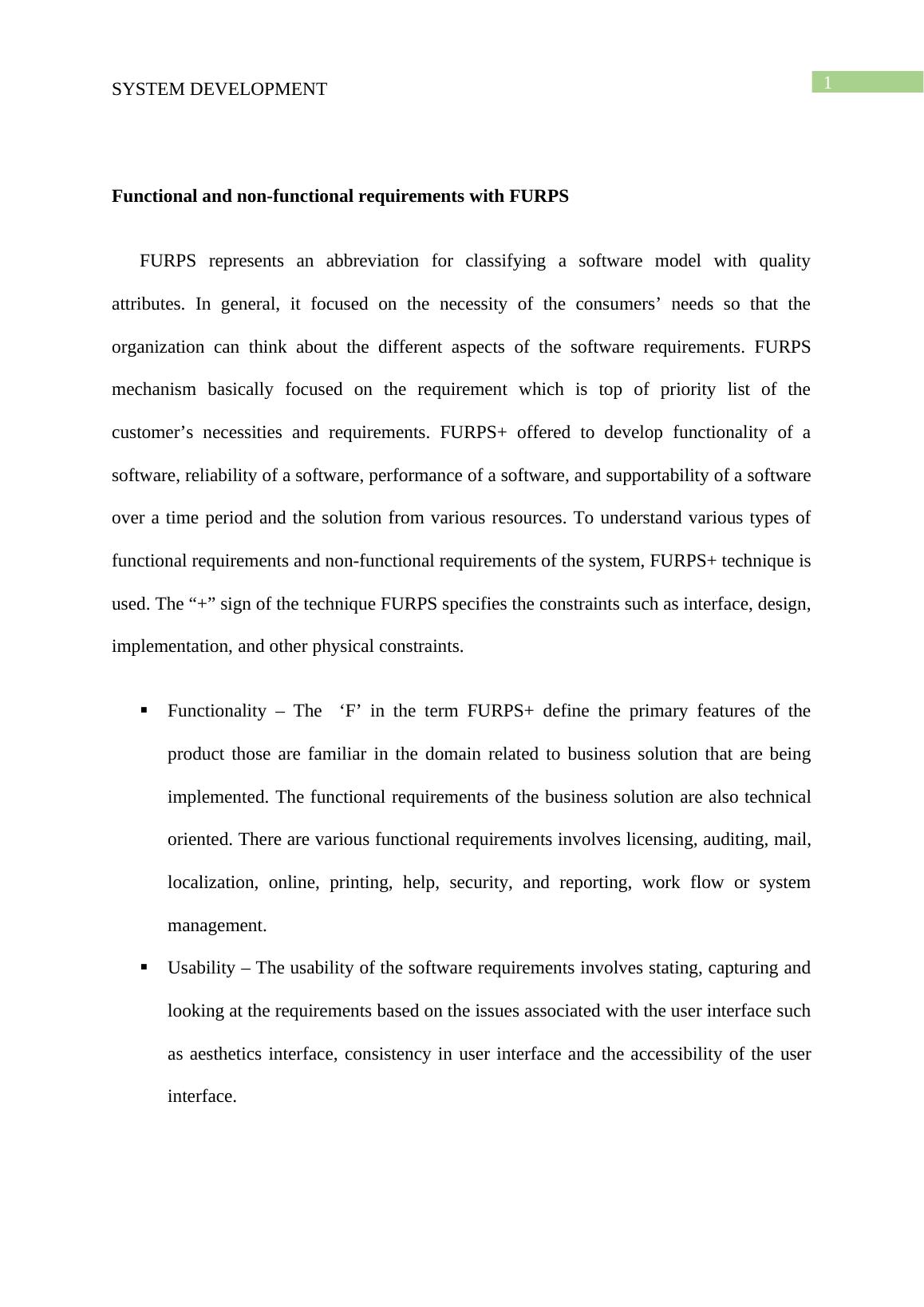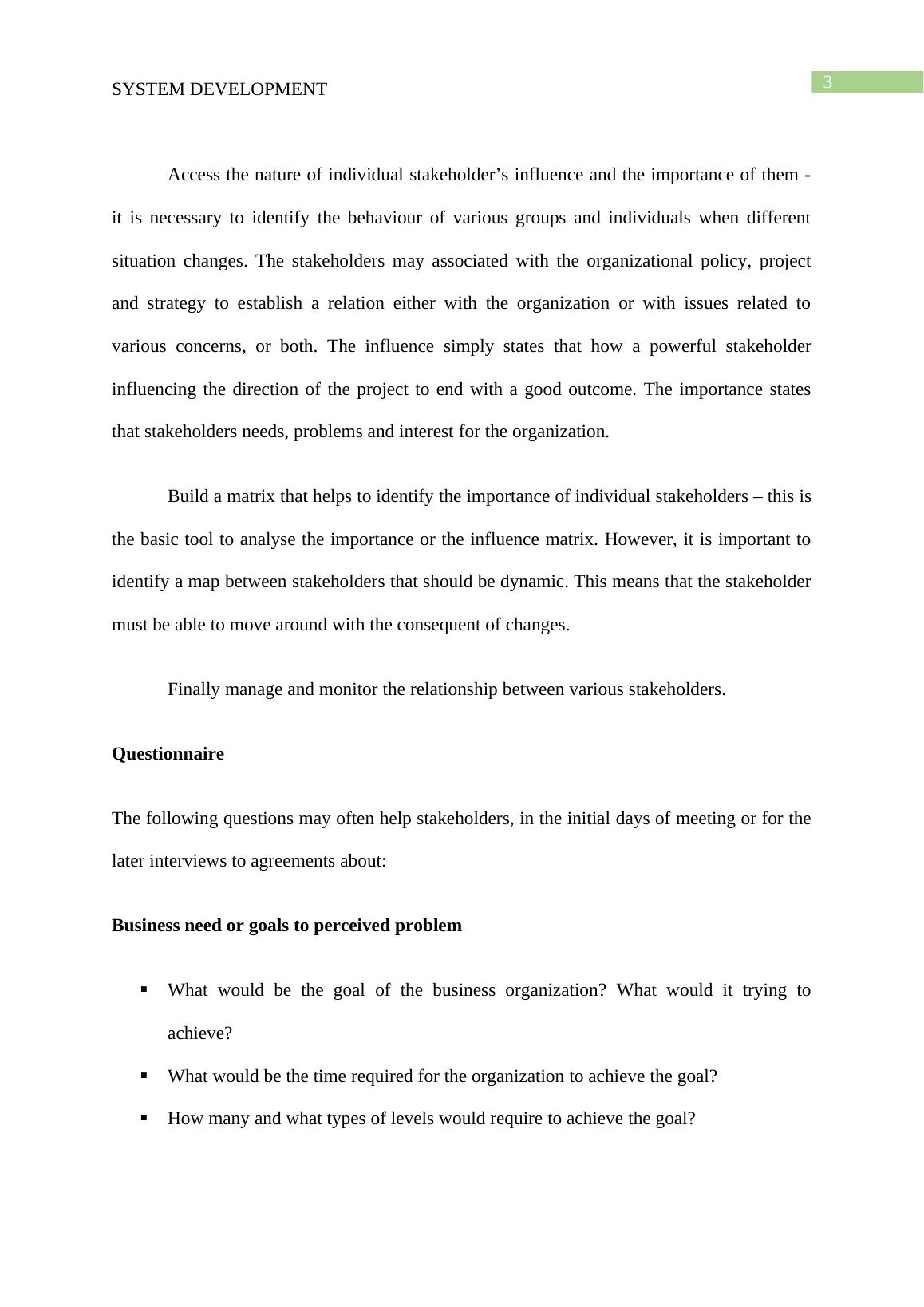Functional and non-functional requirements with FURPS
Added on 2022-12-05
14 Pages1881 Words413 Views
Running head: SYSTEM DEVELOPMENT
System Development
Name of the Student:
Name of the University:
Author note:
System Development
Name of the Student:
Name of the University:
Author note:

1
SYSTEM DEVELOPMENT
Functional and non-functional requirements with FURPS
FURPS represents an abbreviation for classifying a software model with quality
attributes. In general, it focused on the necessity of the consumers’ needs so that the
organization can think about the different aspects of the software requirements. FURPS
mechanism basically focused on the requirement which is top of priority list of the
customer’s necessities and requirements. FURPS+ offered to develop functionality of a
software, reliability of a software, performance of a software, and supportability of a software
over a time period and the solution from various resources. To understand various types of
functional requirements and non-functional requirements of the system, FURPS+ technique is
used. The “+” sign of the technique FURPS specifies the constraints such as interface, design,
implementation, and other physical constraints.
Functionality – The ‘F’ in the term FURPS+ define the primary features of the
product those are familiar in the domain related to business solution that are being
implemented. The functional requirements of the business solution are also technical
oriented. There are various functional requirements involves licensing, auditing, mail,
localization, online, printing, help, security, and reporting, work flow or system
management.
Usability – The usability of the software requirements involves stating, capturing and
looking at the requirements based on the issues associated with the user interface such
as aesthetics interface, consistency in user interface and the accessibility of the user
interface.
SYSTEM DEVELOPMENT
Functional and non-functional requirements with FURPS
FURPS represents an abbreviation for classifying a software model with quality
attributes. In general, it focused on the necessity of the consumers’ needs so that the
organization can think about the different aspects of the software requirements. FURPS
mechanism basically focused on the requirement which is top of priority list of the
customer’s necessities and requirements. FURPS+ offered to develop functionality of a
software, reliability of a software, performance of a software, and supportability of a software
over a time period and the solution from various resources. To understand various types of
functional requirements and non-functional requirements of the system, FURPS+ technique is
used. The “+” sign of the technique FURPS specifies the constraints such as interface, design,
implementation, and other physical constraints.
Functionality – The ‘F’ in the term FURPS+ define the primary features of the
product those are familiar in the domain related to business solution that are being
implemented. The functional requirements of the business solution are also technical
oriented. There are various functional requirements involves licensing, auditing, mail,
localization, online, printing, help, security, and reporting, work flow or system
management.
Usability – The usability of the software requirements involves stating, capturing and
looking at the requirements based on the issues associated with the user interface such
as aesthetics interface, consistency in user interface and the accessibility of the user
interface.

2
SYSTEM DEVELOPMENT
Reliability – The main aspects related to reliability such as accuracy, recoverability
and availability. For example, recovery from the system failure (e.g., shut-down
failure) or computations of the system.
Performance – Performance related to the response time the usability of the system
performance, throughput information generated from the system, start-up time and
recovery time.
Supportability – Lastly, the supportability functionality specifies a range of additional
requirements includes adaptability, testability, compatibility, install-ability,
maintainability, configurability, localizability, scalability and the list goes on.
Stakeholder Map
A method to identify the individuals or the organizations that are included in the
project and is termed as ‘stakeholder analysis’. These are the following steps used to support
the process of analysing various stakeholders:
Identification of various external and internal stakeholders and mapping between
them - the process of arranging various stakeholder is known as stakeholder mapping. This
process investigate the target groups (organizations or individuals) and collect information
about them as much as possible. In an organization the internal stakeholders are the
employees, managements, etc. and the external stakeholders are customers, suppliers and
competitors, etc. The internal stakeholders are those who participated in funding, co-
ordination, resourcing, and publication of a well-being strategy. And, the external
stakeholders are those who contributes their experiences and views to addresses the issues
related to cares, service users and the members of the community.
SYSTEM DEVELOPMENT
Reliability – The main aspects related to reliability such as accuracy, recoverability
and availability. For example, recovery from the system failure (e.g., shut-down
failure) or computations of the system.
Performance – Performance related to the response time the usability of the system
performance, throughput information generated from the system, start-up time and
recovery time.
Supportability – Lastly, the supportability functionality specifies a range of additional
requirements includes adaptability, testability, compatibility, install-ability,
maintainability, configurability, localizability, scalability and the list goes on.
Stakeholder Map
A method to identify the individuals or the organizations that are included in the
project and is termed as ‘stakeholder analysis’. These are the following steps used to support
the process of analysing various stakeholders:
Identification of various external and internal stakeholders and mapping between
them - the process of arranging various stakeholder is known as stakeholder mapping. This
process investigate the target groups (organizations or individuals) and collect information
about them as much as possible. In an organization the internal stakeholders are the
employees, managements, etc. and the external stakeholders are customers, suppliers and
competitors, etc. The internal stakeholders are those who participated in funding, co-
ordination, resourcing, and publication of a well-being strategy. And, the external
stakeholders are those who contributes their experiences and views to addresses the issues
related to cares, service users and the members of the community.

3
SYSTEM DEVELOPMENT
Access the nature of individual stakeholder’s influence and the importance of them -
it is necessary to identify the behaviour of various groups and individuals when different
situation changes. The stakeholders may associated with the organizational policy, project
and strategy to establish a relation either with the organization or with issues related to
various concerns, or both. The influence simply states that how a powerful stakeholder
influencing the direction of the project to end with a good outcome. The importance states
that stakeholders needs, problems and interest for the organization.
Build a matrix that helps to identify the importance of individual stakeholders – this is
the basic tool to analyse the importance or the influence matrix. However, it is important to
identify a map between stakeholders that should be dynamic. This means that the stakeholder
must be able to move around with the consequent of changes.
Finally manage and monitor the relationship between various stakeholders.
Questionnaire
The following questions may often help stakeholders, in the initial days of meeting or for the
later interviews to agreements about:
Business need or goals to perceived problem
What would be the goal of the business organization? What would it trying to
achieve?
What would be the time required for the organization to achieve the goal?
How many and what types of levels would require to achieve the goal?
SYSTEM DEVELOPMENT
Access the nature of individual stakeholder’s influence and the importance of them -
it is necessary to identify the behaviour of various groups and individuals when different
situation changes. The stakeholders may associated with the organizational policy, project
and strategy to establish a relation either with the organization or with issues related to
various concerns, or both. The influence simply states that how a powerful stakeholder
influencing the direction of the project to end with a good outcome. The importance states
that stakeholders needs, problems and interest for the organization.
Build a matrix that helps to identify the importance of individual stakeholders – this is
the basic tool to analyse the importance or the influence matrix. However, it is important to
identify a map between stakeholders that should be dynamic. This means that the stakeholder
must be able to move around with the consequent of changes.
Finally manage and monitor the relationship between various stakeholders.
Questionnaire
The following questions may often help stakeholders, in the initial days of meeting or for the
later interviews to agreements about:
Business need or goals to perceived problem
What would be the goal of the business organization? What would it trying to
achieve?
What would be the time required for the organization to achieve the goal?
How many and what types of levels would require to achieve the goal?

End of preview
Want to access all the pages? Upload your documents or become a member.
Related Documents
System Analysis of Headspace Assignmentlg...
|10
|2671
|376
Functional and Non-functional Requirementslg...
|10
|1306
|389
Non Functional Requirementslg...
|10
|2966
|202
System Analysis & Design: Assignmentlg...
|12
|2698
|93
System Analysis and Design Headspace Organization Assignmentlg...
|12
|2711
|38
System Analysis and Design for Human Resource Management Systemlg...
|18
|3028
|68
